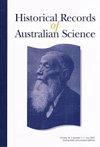詹姆斯·沃尔多·兰斯1926–2019
IF 0.2
4区 哲学
Q4 HISTORY & PHILOSOPHY OF SCIENCE
引用次数: 0
摘要
James W.Lance是一位临床神经学家,他创建了澳大利亚第一个大学神经内科。他倡导学术探究和临床实践的科学基础,他的研究有两个主要主题,运动控制和头痛。在对猫锥体束进行博士研究后,他成为人类受试者运动控制新领域的先驱,在健康受试者的肌肉张力、反射和运动控制以及患者运动障碍的病理生理学方面做出了开创性贡献。与此同时,他开发了一个关于头痛,特别是偏头痛的机制和治疗的临床研究项目。这些研究演变成了在人类受试者、猫和猴子身上进行的平行实验,探索大脑循环的控制和颅面疼痛的潜在机制,为此他在这两个领域都获得了国际赞誉。他获得了国际和澳大利亚的荣誉,是第一位当选为澳大利亚科学院院士的执业临床医生。他领导了澳大利亚和海外学术神经病学的发展,这是理所当然的。本文章由计算机程序翻译,如有差异,请以英文原文为准。
James Waldo Lance 1926–2019
James W. Lance was a clinical neurologist who created the first university-based department of neurology in Australia. He championed academic enquiry and the scientific basis of clinical practice, and his research had two major themes, motor control and headache. After his doctoral studies on the pyramidal tract of the cat, he became a pioneer of the new field of motor control studied in human subjects, making seminal contributions on the control of muscle tone, reflexes and movement in healthy subjects and the pathophysiology of movement disorders in patients. At the same time he developed a clinical research program into the mechanisms and management of headache, in particular migraine. These studies evolved into parallel experiments in human subjects, cats and monkeys, probing the control of the cerebral circulation and the mechanisms underlying craniofacial pain, for which he received international acclaim in both fields. He received international and Australian honours and was the first practising clinician to be elected a fellow of the Australian Academy of Science. He is rightfully credited with leading the development of academic neurology in Australia and overseas.
求助全文
通过发布文献求助,成功后即可免费获取论文全文。
去求助
来源期刊

Historical Records of Australian Science
HISTORY & PHILOSOPHY OF SCIENCE-
CiteScore
0.90
自引率
66.70%
发文量
22
期刊介绍:
Historical Records of Australian Science is a bi-annual journal that publishes two kinds of unsolicited manuscripts relating to the history of science, pure and applied, in Australia, New Zealand and the southwest Pacific.
Historical Articles–original scholarly pieces of peer-reviewed research
Historical Documents–either hitherto unpublished or obscurely published primary sources, along with a peer-reviewed scholarly introduction.
The first issue of the journal (under the title Records of the Australian Academy of Science), appeared in 1966, and the current name was adopted in 1980.
 求助内容:
求助内容: 应助结果提醒方式:
应助结果提醒方式:


